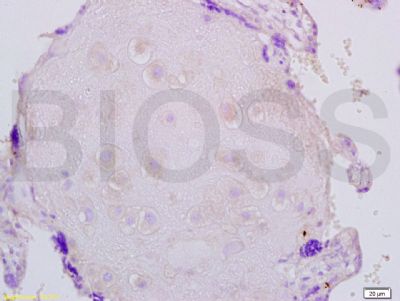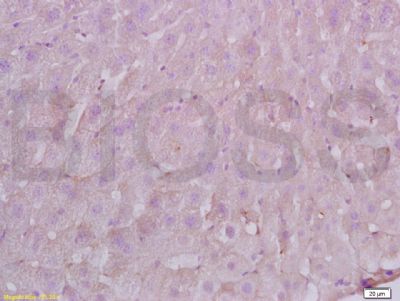产品中心
当前位置:首页>产品中心Anti-Fibrillin 1
货号: bs-1157R 基本售价: 780.0 元 规格: 50ul
- 规格:50ul
- 价格:780.00元
- 规格:100ul
- 价格:1380.00元
- 规格:200ul
- 价格:2200.00元
产品信息
- 产品编号
- bs-1157R
- 英文名称
- Fibrillin 1
- 中文名称
- 原纤维蛋白1抗体
- 别 名
- fibrillin1; 350 kDa glycoprotein component extracellular microfibril; FBN 1; FBN1; FBN; Fibrillin 15; Fibrillin15; Marfan syndrome; MASS; MFS 1; MFS1; OCTD; SGS; Weill Marchesani syndrome; WMS; AI536462; B430209H23; Fib-1; Fibrilin-1; ACMICD; FBN1_HUMAN; GPHYSD2; SSKS; Weill Marchesani syndrome; WMS2.
- 规格价格
- 50ul/780元购买 100ul/1380元购买 200ul/2200元购买 大包装/询价
- 说 明 书
- 50ul 100ul 200ul
- 研究领域
- 免疫学 信号转导 细胞骨架
- 抗体来源
- Rabbit
- 克隆类型
- Polyclonal
- 交叉反应
- Human, Mouse, Rat,
- 产品应用
- ELISA=1:500-1000 IHC-P=1:400-800 IHC-F=1:400-800 IF=1:100-500 (石蜡切片需做抗原修复)
not yet tested in other applications.
optimal dilutions/concentrations should be determined by the end user.
- 分 子 量
- 316kDa
- 细胞定位
- 细胞外基质
- 性 状
- Lyophilized or Liquid
- 浓 度
- 1mg/ml
- 免 疫 原
- KLH conjugated synthetic peptide derived from human FBN1:401-500/2872
- 亚 型
- IgG
- 纯化方法
- affinity purified by Protein A
- 储 存 液
- 0.01M TBS(pH7.4) with 1% BSA, 0.03% Proclin300 and 50% Glycerol.
- 保存条件
- Store at -20 °C for one year. Avoid repeated freeze/thaw cycles. The lyophilized antibody is stable at room temperature for at least one month and for greater than a year when kept at -20°C. When reconstituted in sterile pH 7.4 0.01M PBS or diluent of antibody the antibody is stable for at least two weeks at 2-4 °C.
- PubMed
- PubMed
- 产品介绍
- background:
This gene encodes a member of the fibrillin family. The encoded protein is a large, extracellular matrix glycoprotein that serve as a structural component of 10-12 nm calcium-binding microfibrils. These microfibrils provide force bearing structural support in elastic and nonelastic connective tissue throughout the body. Mutations in this gene are associated with Marfan syndrome, isolated ectopia lentis, autosomal dominant Weill-Marchesani syndrome, MASS syndrome, and Shprintzen-Goldberg craniosynostosis syndrome. [provided by RefSeq, Jul 2008]
Function:
Fibrillins are structural components of 10-12 nm extracellular calcium-binding microfibrils, which occur either in association with elastin or in elastin-free bundles. Fibrillin-1-containing microfibrils provide long-term force bearing structural support. Regulates osteoblast maturation by controlling TGF-beta bioavailability and calibrating TGF-beta and BMP levels, respectively.
Subcellular Location:
Secreted, extracellular space, extracellular matrix.
Post-translational modifications:
Forms intermolecular disulfide bonds either with other fibrillin-1 molecules or with other components of the microfibrils.
DISEASE:
Defects in FBN1 are a cause of Marfan syndrome (MFS) [MIM:154700]. MFS is an autosomal dominant disorder that affects the skeletal, ocular, and cardiovascular systems. A wide variety of skeletal abnormalities occurs with MFS, including scoliosis, chest wall deformity, tall stature, abnormal joint mobility. Ectopia lentis occurs in up to about 80% of MFS patients and is almost always bilateral. The leading cause of premature death in MFS patients is progressive dilation of the aortic root and ascending aorta, causing aortic incompetence and dissection. Note=The majority of the more than 600 mutations in FBN1 currently known are point mutations, the rest are frameshifts and splice site mutations. Marfan syndrome has been suggested in at least 2 historical figures, Abraham Lincoln and Paganini.Defects in FBN1 are a cause of isolated ectopia lentis (EL) [MIM:129600]. The symptoms of this autosomal dominant fibrillinopathy overlap with those of Marfan syndrome, with the exclusion of the skeletal and cardiovascular manifestations.Defects in FBN1 are the cause of Weill-Marchesani syndrome autosomal dominant (ADWMS) [MIM:608328]. A rare connective tissue disorder characterized by short stature, brachydactyly, joint stiffness, and eye abnormalities including microspherophakia, ectopia lentis, severe myopia and glaucoma.Defects in FBN1 are a cause of Shprintzen-Goldberg craniosynostosis syndrome (SGS) [MIM:182212]. SGS is a very rare syndrome characterized by a marfanoid habitus, craniosynostosis, characteristic dysmorphic facial features, skeletal and cardiovascular abnormalities, mental retardation, developmental delay and learning disabilities.Defects in FBN1 are a cause of overlap connective tissue disease (OCTD) [MIM:604308]. A heritable disorder of connective tissue characterized by involvement of the mitral valve, aorta, skeleton, and skin. MASS syndrome is closely resembling both the Marfan syndrome and the Barlow syndrome. However, no dislocation of the lenses or aneurysmal changes occur in the aorta, and the mitral valve prolapse is by no means invariable.Defects in FBN1 are a cause of stiff skin syndrome (SSKS) [MIM:184900]. It is a syndrome characterized by hard, thick skin, usually over the entire body, which limits joint mobility and causes flexion contractures. Other occasional findings include lipodystrophy and muscle weakness.
Similarity:
Belongs to the fibrillin family.
Contains 47 EGF-like domains.
Contains 9 TB (TGF-beta binding) domains.
SWISS:
P35555
Gene ID:
2200
Database links:Entrez Gene: 2200Human
Entrez Gene: 83727Rat
Omim: 134797Human
SwissProt: P35555Human
SwissProt: Q61554Mouse
Unigene: 591133Human
Unigene: 271644Mouse
Unigene: 12759Rat
Important Note:
This product as supplied is intended for research use only, not for use in human, therapeutic or diagnostic applications.
Fibrillin-1广泛存在于皮肤、肺、肾、血管、软骨、睫装小体等,原纤维蛋白1在产生强而韧性的组织中起重要作用,是组织连结重要的蛋白。
- 产品图片
 Tissue/cell: human placenta tissue; 4% Paraformaldehyde-fixed and paraffin-embedded;
Tissue/cell: human placenta tissue; 4% Paraformaldehyde-fixed and paraffin-embedded;
Antigen retrieval: citrate buffer ( 0.01M, pH 6.0 ), Boiling bathing for 15min; Block endogenous peroxidase by 3% Hydrogen peroxide for 30min; Blocking buffer (normal goat serum,C-0005) at 37℃ for 20 min;
Incubation: Anti-FBN1 Polyclonal Antibody, Unconjugated(bs-1157R) 1:200, overnight at 4°C, followed by conjugation to the secondary antibody(SP-0023) and DAB(C-0010) staining Tissue/cell: rat liver tissue; 4% Paraformaldehyde-fixed and paraffin-embedded;
Tissue/cell: rat liver tissue; 4% Paraformaldehyde-fixed and paraffin-embedded;
Antigen retrieval: citrate buffer ( 0.01M, pH 6.0 ), Boiling bathing for 15min; Block endogenous peroxidase by 3% Hydrogen peroxide for 30min; Blocking buffer (normal goat serum,C-0005) at 37℃ for 20 min;
Incubation: Anti-FBN1 Polyclonal Antibody, Unconjugated(bs-1157R) 1:200, overnight at 4°C, followed by conjugation to the secondary antibody(SP-0023) and DAB(C-0010) staining

